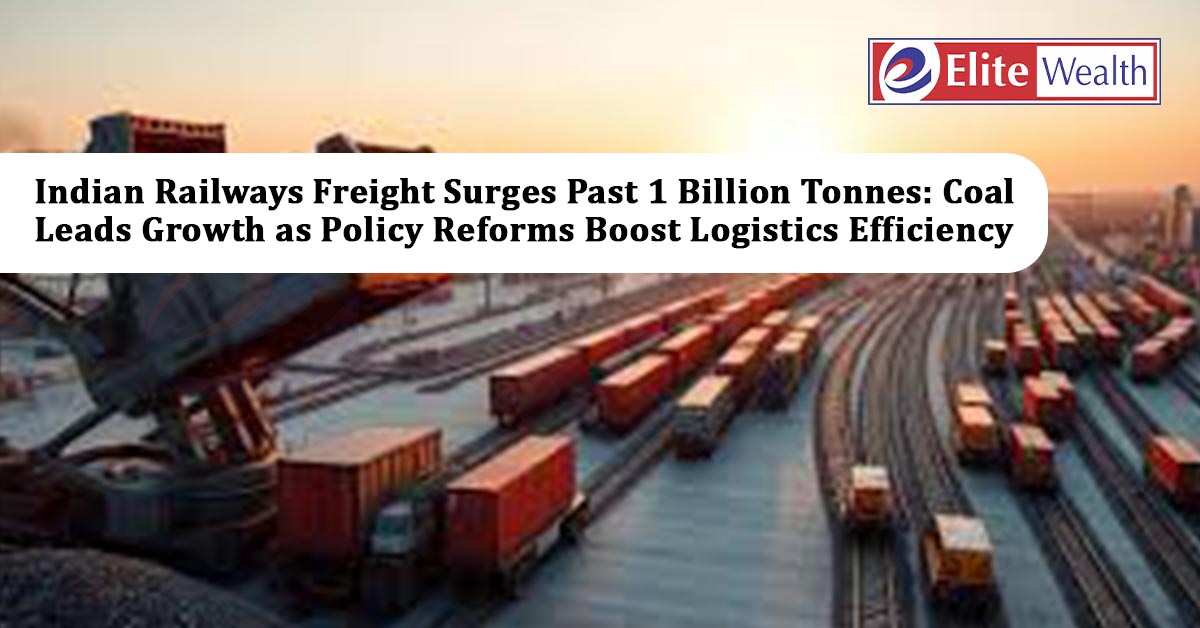
Indian Railways has marked a major milestone, with cumulative freight loading exceeding the 1-billion-tonne threshold for the year. As of November 19, 2025, total freight loading stands at 1,020 Million Tonnes (MT), reflecting strong demand from core industries and improved operational performance across the network.
Daily loading levels have also shown notable progress, averaging 4.4 MT, compared with 4.2 MT last year—an indication of growing efficiency and sustained market momentum.
Sector-Wise Drivers of Growth
The freight surge has been powered by broad-based contributions from key sectors:
| Sector | Freight Loaded (MT) |
| Coal | 505 MT |
| Iron Ore | 115 MT |
| Cement | 92 MT |
| Container Traffic | 59 MT |
| Pig Iron & Finished Steel | 47 MT |
| Fertilisers | 42 MT |
| Mineral Oil | 32 MT |
| Foodgrains | 30 MT |
| Raw Materials for Steel Plants | 20 MT |
| Other Goods | 74 MT |
Coal remains the largest contributor, driving over 50% of total freight movement, while other sectors such as cement, iron ore, and container traffic continue to demonstrate strong performance.
Year-on-Year Growth Strengthens Momentum
From April to October 2025, Indian Railways recorded freight loading of 935.1 MT, an increase from 906.9 MT during the same period last year. This steady YoY growth reflects strengthening industrial activity and the railways’ expanding role in supporting India’s infrastructure-led economic push.
Policy Reforms Transforming Cement Logistics
Recognising the crucial role of cement in the nation’s infrastructure expansion, Indian Railways has introduced important policy reforms to improve logistics efficiency. The Policy for Bulk Cement Terminals, along with the rationalisation of container-based cement movement rates, is expected to significantly strengthen the sector.
These initiatives aim to:
- Enhance bulk handling and storage capacity
- Reduce transit time and improve turnaround
- Lower logistics costs
- Boost end-to-end supply chain efficiency
The reforms signal a strategic move toward upgrading rail-based logistics for one of India’s most critical industries.
Environmental & Economic Advantages of Rail Freight
Rail-based cargo movement offers far-reaching benefits beyond cost savings. By shifting bulk freight to rail, India can:
- Cut carbon emissions significantly
- Reduce highway congestion and road wear-and-tear
- Support greener logistics for industries, including MSMEs
These improvements contribute directly to India’s Net Zero Carbon Emission goals, and reaffirm the Railways’ role as a cornerstone of sustainable economic growth.
Summary
Indian Railways has crossed the 1 billion tonne freight milestone, with strong sectoral demand—particularly from coal—driving the surge. Year-on-year growth, supported by progressive logistics reforms in sectors like cement, highlights the Railways’ rising efficiency and its importance to India’s industrial ecosystem. With economic, environmental, and operational advantages, the freight sector is poised for continued expansion, strengthening India’s infrastructure and sustainability ambitions.
Disclaimer:
This article is intended solely for educational and informational purposes. The securities or companies mentioned are provided as examples and should not be considered as recommendations. Nothing contained herein constitutes personal financial advice or investment recommendations. Readers are advised to conduct their own research and consult a qualified financial advisor before making any investment decisions.
Investments in securities markets are subject to market risks. Please read all related documents carefully before investing.
